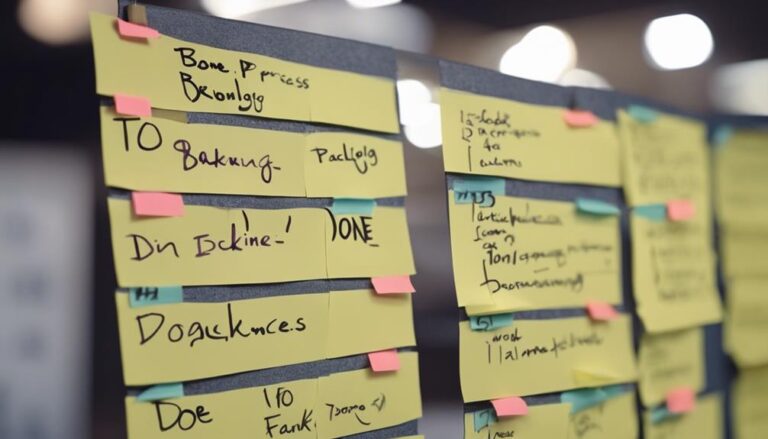You might wonder if integrating Scrum and Kanban could create more complexity in your project management approach. However, when used together strategically, these methodologies can offer a harmonious balance that maximizes efficiency and productivity.
By understanding how to harness the unique strengths of both Scrum and Kanban, you can create a dynamic system that adapts to your team's needs and project requirements seamlessly.
This fusion of methodologies opens up a world of possibilities for enhancing your project management practices, allowing you to achieve optimal results with a blend of structure and flexibility.
Key Takeaways
- Enhance efficiency and transparency with combined methodologies
- Foster adaptive workflow and optimize project delivery
- Improve collaboration, adaptability, and project outcomes
- Balance structured sprint cycles with visual workflow for optimal results
Benefits of Combining Scrum and Kanban
By seamlessly integrating Kanban practices into your Scrum framework, you can enhance efficiency and transparency in project management, fostering a more adaptive and collaborative workflow. Combining Scrum and Kanban methodologies enables agile teams to optimize flow, improving efficiency, effectiveness, and predictability in project delivery. Within the agile project management context, the infusion of Kanban practices enhances visibility, inspection, and adaptation frequency, complementing the core principles of Scrum.
Agile teams benefit from the seamless integration of Scrum and Kanban by improving collaboration, adaptability, and overall project outcomes without disrupting established processes. The synergy between these methodologies results in a holistic approach to project management, leveraging the strengths of both frameworks. By adding Kanban practices to the existing Scrum framework, teams can enhance existing accountabilities, events, and artifacts, leading to a more transparent and adaptive workflow. This integration allows for a more efficient and collaborative environment, where teams can work together seamlessly towards achieving project goals.
Agile Principles in Project Management
Embracing agile principles in project management fosters a culture of iterative development and customer engagement, driving value and responsiveness in your team's deliverables. By incorporating Scrum, Kanban, and other agile methodologies, you create a dynamic environment where adaptability is key. Agile principles encourage project managers to respond swiftly to changes, ensuring that the team delivers efficiently and effectively. Collaboration, transparency, and continuous improvement are at the core of agile project management, enabling teams to work together seamlessly towards common goals.
Scrum and Kanban align perfectly with agile principles, providing frameworks that emphasize flexibility and adaptability. These methodologies empower project managers to optimize processes, enhance communication, and streamline workflows. By leveraging agile principles in conjunction with Scrum and Kanban, you can achieve a balance between structure and flexibility, ultimately leading to successful project outcomes. Embracing agile methodologies not only improves project management practices but also fosters a culture of innovation and excellence within your team.
Key Elements of Scrum and Kanban Integration
Let's focus on the key elements that make Scrum and Kanban integration successful.
Process synchronization techniques, workflow visualization benefits, and continuous improvement strategies play vital roles in combining these methodologies effectively.
Understanding how these elements work together can enhance your project management approach and drive successful outcomes.
Process Synchronization Techniques
To synchronize processes effectively in Scrum and Kanban integration, combine the structured sprints of Scrum with Kanban's work-in-progress limits. By blending these methodologies, you can balance the fixed time frames of sprints with Kanban's focus on continuous flow. This fusion allows for a more streamlined workflow that maintains a steady pace while preventing overload.
Through this synchronization, teams can enhance project management by incorporating the best of both worlds: the predictability of sprints and the flexibility of Kanban. By leveraging these techniques, you enable improved coordination, increased efficiency, and better adaptability to changes.
Embracing the synchronization of processes in Scrum and Kanban integration empowers teams to work collaboratively towards achieving optimal project outcomes.
Workflow Visualization Benefits
Incorporate the benefits of workflow visualization into your project management approach by seamlessly blending Scrum's sprint phases with Kanban's visual work-in-progress limits. By integrating Scrum and Kanban, you enhance transparency and track progress through Kanban boards, enabling better project phase representation and work item visualization.
Scrumban's visual workflow aids in identifying bottlenecks, prioritizing tasks, and maintaining a steady work flow. This integration allows for real-time task monitoring and efficient resource allocation, optimizing processes and improving overall project management.
With workflow visualization, teams utilizing Scrumban can readily adapt to changes, fostering a culture of continuous improvement and enabling them to respond effectively to evolving project requirements.
Continuous Improvement Strategies
Enhance your project management practices through the seamless integration of Scrum's sprint methodology and Kanban's visual workflow to drive continuous improvement strategies.
By conducting regular retrospectives, teams can pinpoint areas for enhancement based on feedback, fostering a culture of continuous improvement. Kanban's visual workflow enables the identification of bottlenecks, allowing teams to optimize processes and ensure smoother project management.
The iterative enhancements facilitated by Scrum's sprints and Kanban's continuous flow methodology promote adaptability and efficiency within the project lifecycle. Integrating Scrum's sprint reviews with Kanban's visualization aids in tracking progress and making informed, data-driven decisions for improvement.
Embrace the combined power of Scrum and Kanban to achieve optimal project management through a focus on continuous learning and improvement.
Implementing Scrum and Kanban Together
Consider blending Scrum's structured sprints with Kanban's visual workflow to optimize project management efficiency. By implementing Scrumban, which combines the best of both methodologies, you can enjoy the flexibility of Kanban while maintaining the structure of Scrum. This integration allows your team to adapt quickly to changing project requirements, fostering a dynamic and responsive work environment. The collaboration and communication within the team are enhanced, promoting a transparent workflow that highlights progress and identifies bottlenecks promptly.
Utilizing Scrum and Kanban together offers a comprehensive view of the project's status, helping to streamline processes and improve overall productivity. The combined approach empowers your team to work more efficiently, delivering high-quality results within set timelines. Embracing Scrumban not only increases project efficiency but also nurtures a culture of continuous improvement and teamwork. By merging these methodologies, you create a harmonious blend that maximizes your team's potential and project success.
Maximizing Efficiency With Hybrid Methodologies
Let's explore the advantages of combining Agile methodologies like Scrum and Kanban to maximize efficiency in project management.
By leveraging the benefits of both approaches, you can create a synergy that enhances your team's productivity and adaptability.
Embracing this hybrid methodology allows for a balanced mix of structured sprint cycles and visual workflow management, leading to optimal project outcomes.
Agile Combination Benefits
Maximize project efficiency and collaboration by leveraging the benefits of combining Scrum and Kanban methodologies in a hybrid approach known as Scrumban. Embrace the Agile combination benefits through Scrumban with the following advantages:
- Optimized Project Management: Utilize Scrum's structured approach and Kanban's visual workflow for enhanced project management.
- Enhanced Efficiency: Incorporate Scrum's sprints and standups with Kanban's work-in-progress limits and continuous flow to boost productivity.
- Flexibility and Adaptability: Enjoy the benefits of a versatile methodology that allows for continuous improvement and adaptability.
- Balanced Solution: Combine the best of both methodologies to achieve a balanced solution that maximizes team productivity and collaboration.
With Scrumban, you can seamlessly blend Scrum and Kanban to create a powerful project management approach that delivers results.
Synergy Between Approaches
To optimize project management efficiency through the integration of Scrum and Kanban, embrace the synergistic benefits of their hybrid approach known as Scrumban. Scrumban combines the structured framework of Scrum with the visual workflow optimization of Kanban, offering a flexible yet structured methodology for project management.
By merging Scrum's sprints with Kanban's work-in-progress limits, Scrumban enhances team efficiency and adaptability, providing a balanced mix of both methodologies. This hybrid approach fosters collaboration and communication within teams, leveraging the strengths of both Scrum and Kanban.
Ultimately, the synergy between these approaches in Scrumban results in optimal project management practices, allowing teams to maximize productivity and achieve project goals effectively.
Agile Tools for Seamless Integration
Utilize agile tools for seamless integration of Scrum and Kanban methodologies to streamline project management practices efficiently. When combining these approaches, it's essential to leverage the right tools to enhance collaboration and workflow visibility.
Consider the following agile tools for optimal integration:
- Jira Software: Customize boards for both Scrum and Kanban methodologies.
- Trello and Asana: Support seamless integration of Scrum and Kanban practices.
- Monday.com: Enhance collaboration and provide clear workflow visibility.
- VersionOne and Targetprocess: Offer features that effectively combine Scrum and Kanban practices.
These agile project management software options, such as AgileCraft and LeanKit, play a crucial role in facilitating the integration of Scrum and Kanban, ensuring a smooth and efficient project management process. By utilizing these tools, you can create a cohesive environment that maximizes the benefits of both methodologies while promoting effective collaboration among team members.
Case Studies on Dual Methodology Implementation
Enhancing project outcomes through the strategic integration of Scrum and Kanban methodologies showcases the potential for improved efficiency and effectiveness in project management practices.
Several case studies highlight the success of dual methodology integration. Company X saw a 25% increase in project throughput by combining Scrum sprints with Kanban's work-in-progress limits. Team Y reduced lead time by 30% by integrating Scrum's sprint planning with Kanban's visual workflow management.
Moreover, Organization Z achieved 15% higher customer satisfaction ratings by leveraging Scrum's sprint retrospectives alongside Kanban's continuous delivery approach. Team A experienced a 20% decrease in bottlenecks by implementing Scrum standups and Kanban WIP limits.
Additionally, Project B witnessed a 35% increase in team productivity by using Scrum for planning and Kanban for execution. These case studies demonstrate the tangible benefits that can be achieved through the thoughtful combination of Scrum and Kanban methodologies.
Continuous Improvement Strategies for Teams
Teams in Scrumban prioritize continuous improvement through regular retrospectives, fostering a culture of adaptation and evolution to enhance project outcomes. Embracing feedback and metrics, teams strive for ongoing enhancement.
Here are some strategies for teams to achieve continuous improvement:
- Engage in Regular Retrospectives: Schedule frequent retrospective meetings to reflect on past sprints, celebrate successes, and address challenges towards improvement.
- Utilize Feedback Loops: Actively seek feedback from team members and stakeholders to identify areas for refinement and make necessary adjustments.
- Track Key Metrics: Use metrics to measure team performance, identify bottlenecks, and drive decision-making for process optimization.
- Encourage Collaboration: Foster a collaborative environment where team members openly share ideas, best practices, and lessons learned to enhance overall team performance.
Frequently Asked Questions
How Do I Use Scrum and Kanban Together?
To use Scrum and Kanban together for efficiency optimization, integrate workflows seamlessly, creating an agile hybrid. Embrace collaboration synergy, enhancing process improvement. Leverage Scrum's structured framework and Kanban's flexibility for optimal project outcomes.
What Are the Benefits of Combining Scrum and Kanban?
Boost your team's productivity with improved prioritization, streamlined processes, and increased collaboration. Embrace the synergy of Scrum and Kanban for enhanced flexibility in project management. Experience the benefits of combining these methodologies firsthand.
Can Scrum and Kanban Exist in the Same Project?
Yes, Scrum and Kanban can coexist in a project. This hybrid approach, known as Scrumban, combines structured sprints with visual workflow management. It enhances team collaboration, optimizes workflows, and overcomes implementation challenges, leading to efficient project delivery.
Which Project Management Framework Combines Scrum and Kanban?
To blend Scrum and Kanban for optimal project management, a hybrid approach known as Scrumban integrates agile methodologies, optimizing workflow, synchronizing processes, and offering an agile integration. It's a collaborative and efficient way to enhance your project management.
Conclusion
As you reflect on the benefits of combining Scrum and Kanban in project management, consider exploring the theory that true success lies in the continuous evolution and refinement of your Agile practices.
By embracing a dual methodology approach, teams can adapt, collaborate, and optimize their workflows to achieve optimal efficiency and productivity.
Remember, the key to success isn't just in the methodologies themselves, but in the willingness to continuously improve and evolve in pursuit of excellence.





